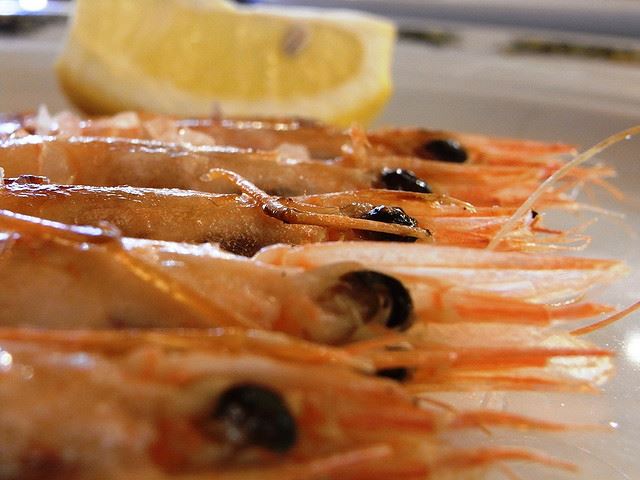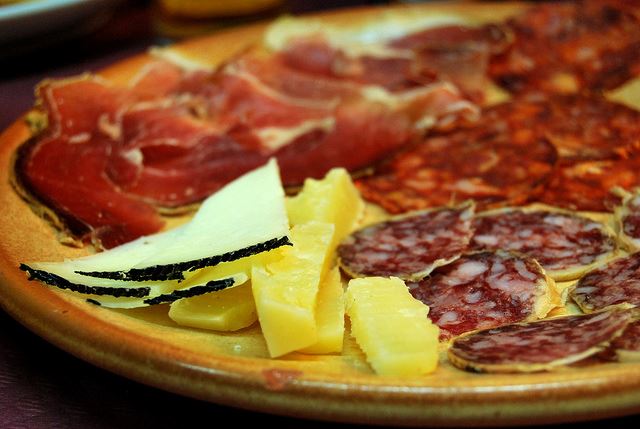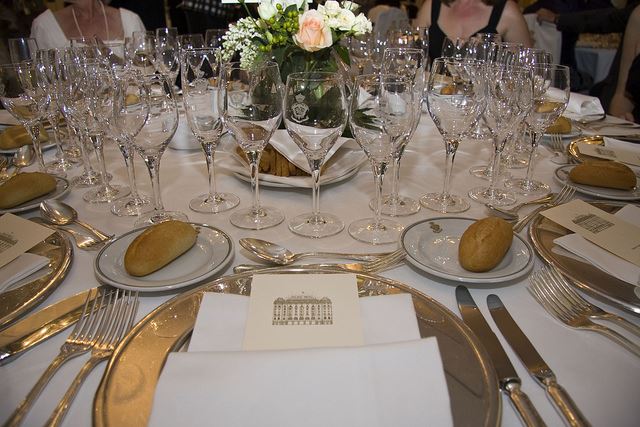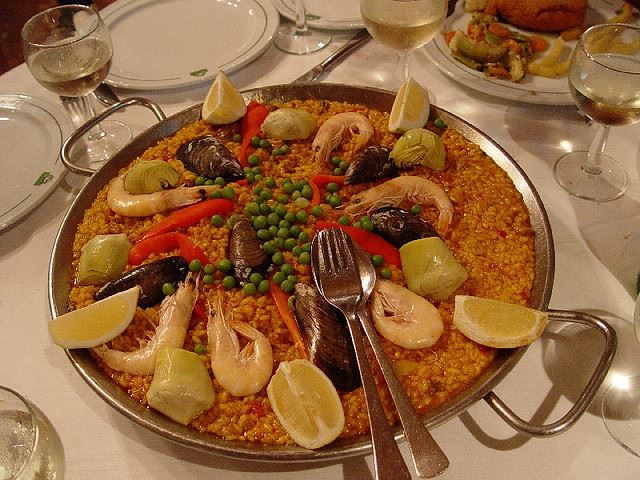If you only spend a day in Spain, you can’t help noticing how people love to share food. It’s so intrinsic to the dining experience that it’s built into the menus. But do you know what to share and how to share it in Spain? We’ve been designing custom itineraries in Spain and Portugal for two decades and here are our pro-tips to exactly that:-
The Art, Love and Tradition of Sharing Food in Spain
1 Do you really share dishes in Spain?
Yes! Outside of breakfast, if you’re travelling in Spain, you’ll have countless opportunities to share a morsel. In many bars, the only food you’ll find will be meant for sharing. Meatballs, croquetas and meat platters – they are all to share or ‘para compartir’. Even in restaurants, the first course is generally shared. ‘Algo para picar’ (something to nibble on) you might say while you are waiting for your mains. For example, for a table of four, you might share a something cold such as a salad (ensalada or ensaladilla for a Russian salad) and something hot such as garlicky prawns, and each person then orders their own main course. The exception here is the set-price meal (menu del dia) which we’ll talk about later on.

A row of prawns with heads and tails – perfect food for sharing in Spain. photo credit: jlastras via photopin cc
And sharing can continue on into the main course also. A table of four people can order a selection of dishes from the starters and mains sections of the menu and have each served as a shared dish for all to taste and experience. It adds to the drama of the experience as each dish is given its own moment under the spotlight and is enjoyed and discussed. When doing this, restaurants will usually recommend dishes that are suited to sharing – or advise that you might need to order two of something rather than just one – for example if you are having scallops or oysters and you want to have a piece each. You’ll also be advised the order in which the dishes will arrive.
2 What’s Suitable for Sharing?
Many dishes lend themselves to sharing rather than being eaten on their own – for example – you wouldn’t want to eat a portion of black pudding (morcilla) on your own. Likewise, a platter of cured meats (embutidos) or squid (calamares/rabas) for one person would be too monotonous – much better to share these platters and get a contrasting dish such as a leafy green salad or some vegetables such as stuffed peppers as well. Waiters are usually very helpful when recommending good combinations and pay attention to the house specials as well – whether that’s chorizo in cider (a la sidra) or cured beef (cecina).

A platter of embutidos or cured meats and cheese – better among 2 or 3 people. photo credit: Aerismaud via photopin cc
Sometimes main courses are trickier to share and you’ll need to know who you are eating with. For example, whilst it’s easy for the kitchen staff to cook a juicy sirloin steak and slice it into thick strips – if one person likes it rare and the other well done it’s not going to work. If you are sharing red meat dishes, you’d better ask your fellow dining partners how they like their meat and if needs be, you can always send a section of the dish back in for an extra charring. Fish dishes are generally easier to share – and when you explain that two or more people are sharing – you will be offered a raft of options that may not be on the menu – such as fish baked in salt (pescado al sal), paella and other rice dishes that are usually prepared for a minimum or two people. Many of the seasonal fish dishes such as grilled sardines (sardinas) are better fun when shared. Much better for all the hands and mouths at a table to be oily than just yours!

The paella is usually only available for a minimum of two people. photo credit: dominiccampbell via photopin cc
3 How Do You Serve Shared Food?
Usually when sharing dishes, each person will be given a normal or side plate and the dish will be served in the centre. One person can choose to divide the item and serve each person individually or each serves their share or part of their share. Exceptions here would be with platter of cured meats or cheeses where you many not be given side plates – you might just use your fork to skewer a piece of meat and pop it onto a piece of bread as you drink your wine. And you’d be mad not to pick up a piece of cheese with your hands. Some shared food just has to be handled.
Often, when the numbers don’t divide perfectly, e.g. with a platter of mussels or clams, you’ll often see a single item left on the platter for ages – which in Spain is untouched out of shyness (por la verguenza). Usually the waiter will encourage one of the diners to go for it before clearing the plates.

Broken Eggs or Huevos Rotos are one of the commonly shared egg dishes. photo credit: el Pachinko via photopin cc
Egg-based dishes are eaten and shared a little differently in Spain. If you are having a snack in a bar, and fancy some ‘tortilla’ you might not even be given a knife. The cutting of eggs is usually done with the fork in Spain and a piece of bread is used to offer resistance to the item and the fork. When it comes to sharing egg dishes, ‘huevos rotos’ are a popular choice. Consider it like an egg and chip where the egg is broken (meaning ‘roto’) over the chips. They are eaten in the same way that ‘patatas bravas’ are so grab your fork and try not to dribble the runny egg on your fellow diners.
4 Sharing & The Need for Cutlery, Cleanliness and Serviettes
Although it is possible to eat ribs (costillas) or prawns (gambas) with a knife and fork, most Spaniards will tend to down tools and crack open the prawn with their hands and pull off its head. You shouldn’t be surprised to see polite company sucking the head of the prawn as well. Prawns are usually served at weddings and it’s always impressive to see how well manicured nails and silk outfits seem to remain pristine after a few platters of seafood. At weddings and formal restaurants, you’ll be given a wet wipe to clean the debris off your hands. In bars, you’ll see serviettes in the little holders on the bar and dotted around the tables. If you happen to get a nasty stain on your clothes while in a bar or restaurant, you can ask your waiter whether they have any cleaning spray – most places will have something to shift an oily mark.

You will rarely find a plate for your bread in Spain. Here – at a wedding – is the exception. photo credit: MShades via photopin cc
Except at weddings and the more formal of events, small side plates are used for sharing food in bars rather than for resting bread or anything else on. When you take a piece of bread from the bread basket in the less formal restaurants, leave it beside your wine glass – never on your plate.
5 Is it Acceptable to Mop Up Juices from a Shared Platter with Bread?
You might be wondering whether it’s polite to mop up the meat juices or sauces from a shared fish platter? Our advice is to look around. If it’s a fine-dining restaurant, we might spoon it onto our own plate. It its rough and ready, chuck a piece of bread into the central plate and scoop it out with your fork or your fingers – depending on how well you know you fellow guests. If you are in a bar, you’ll need to use the bread for everything from acting as a plate – pop oily food items such as cheese, anchovies and sardines on top of a piece of bread to avoid them dripping on you. And for mopping up sauces, again bread is your ally. (BTW If you happen to swallow a fishbone, bread is the solution as well.) Feel free to order more bread if you need to – you may or may not be charged but it’s usually not expensive. And if you happen to be travelling with a small child, you can usually ask for copious amounts of bread – para el niño…

Wherever you put it, bread is your friend when it comes to mopping up sauces. photo credit: Unhindered by Talent via photopin cc
6 What To Do with the Debris when Sharing?
Where do you put the prawn heads and the olive stones and the spines of the sardines? On the side of your plate is the best option. If you are eating in a rural or rustic place, you can scrape them back onto the central plate when the contents of the plate have been finished and you need the space on your plate for the other platters. If you are in a nice restaurant, your food will probably be served individually and your plate taken away after each mini-course.
7 How to Share Wine, Desserts, Digestifs and Snacks
No – don’t worry – you don’t have to share a glass of wine with anybody. But if you are sharing a bottle, you should know that glasses are usually only half filled here – in fact – even if you order by the glass you’ll never see it filled more than half way up – that’s to let it breathe and help you to swirl it around so you can enjoy the wine. The worldwide phenomenon of one dessert and two or more spoons is perfectly acceptable in Spain. In fact, you’ll probably be brought extra spoons without having to ask for them. If the party is offered a digestif, it’s perfectly normal for one person in a group to ask to taste another’s drink.
And while we are talking of something sweet, everybody’s favourite snack – churros – are the perfect example of how good sharing can be. Although rather than sharing, it can often be a debate about who ate the churros!

Churros are more of a snack than a dessert but oh so good for sharing!! photo credit: Brian W. Tobin via photopin cc
8 How to Avoid Sharing – if that’s not your thing?
If you don’t like the idea of sharing food with others – then you need to say that. By all means, allow the others in your party to share, but make sure you say to the waiter that you don’t want to. ‘Lo mio no es para compartir’ (Mine is not for sharing). The reason you need to do this is because you might not be served your dish until the end. Another way to get around this is to say that everything should be brought to the table at the same time (tráenos todo a la vez). The best option for not sharing is to pick a set-price menu deal (menu del dia) which usually offers great regional cooking and value for money. The exception here would be tourist traps in front of the main monuments in Spain. Always try to stray at least one of two streets from the main drag when looking for a good ‘menu del dia’.

Have a few pinchos if you are very hungry and will end up sharing food – that way you won’t snaffle up everything on the first few plates. photo credit: robertpaulyoung via photopin cc
9 Sharing with a Hearty Appetite
We came across some very tall Finnish basketball players in a bar in Bilbao who were up for trying the local Basque cuisine but it was obvious that these guys weren’t going to be full after sharing a few raciones (platters). If you have a large appetite but don’t want to miss out on the sharing in Spain, you should have a tapa or two at the bar before taking to a table and ordering a couple of platters to share. If you need a more balanced meal, ask about stews and casseroles (platos de puchero/cuchara) that are usually served in a big pot in the centre of the table. You usually find one of these as the starter to a three course set-price meal. If you need carbs and can’t find a casserole/menu del dia, look for a mixed-grill platter (plato combinado). If you are in a place that only serves shared ‘raciones’ ask whether they can come with fries or order some extra bread or a salad.

The ‘plato combinado’ is a handy option for people who don’t wish to share food. photo credit: [dac] via photopin cc
Given the theatre of your average Spanish restaurant, it can be one of the easier places to dine out alone. If you want to try as much as possible but can’t share with anybody, ask your waiter whether you can order half portions (media racion/porcion) and order 2-4 half portion dishes – you waiter can advise on the size of the dishes. More and more restaurants are serving half portions which is fantastic not just to try more on the menu but also for people on reduced-calorie diets, limited budgets and indeed for children. If you are among this list, ask your waiter whether you can order half portions and get experimenting…
11 The Sharing Never Stops – Bring Something Home to Share with Your Family & Friends!
Sharing food in Spain is a way of life. It happens in bars, restaurants, homes and on holidays. Spaniards going to a different city or region on holidays or for work will often bring back significant amounts of food for themselves and even take orders for local delicacies from friends, family and work colleagues. Likewise a Spaniard visiting friends abroad knows s/he needs to bring some of the home treats over with them. If you don’t know what that is, you’ll find it stacked up at motorway filling stations and in shops in the airports.

The retro looking packaging is as appealing as the gift – breakfast sobaos from Cantabria. photo credit: by onnoth via photopin cc
Here are some handy examples by region:
- From Cantabria, you’re talking about a packet of sobaos (buttery breakfast sponge cakes), anchovies, cheese and the Orujo liquer.
- In Burgos – pick up some black pudding (morcilla)
- Asturias – don’t forget to bring some fabada beans or cider or the blue Cabrales cheese
- Riojan wine and vegetables
- Manchego cheese from Castile la Mancha
- Salamanca for cured meats
- Extremadura for Pimenton de la Vera
- Olive oil from Jaen
- Marzipan from Toledo

Sharing paella – if you really want to taste a good paella, you have to order one to share. photo credit: coda via photopin cc
If you’ve enjoyed this useful food guide, you should check out our other guides to the menu del dia in Spain, mealtimes in Spain, tipping in Spain, taking a food tour in Spain, and quirky food customs in Spain.
